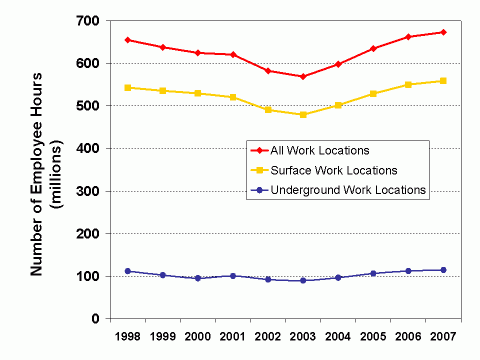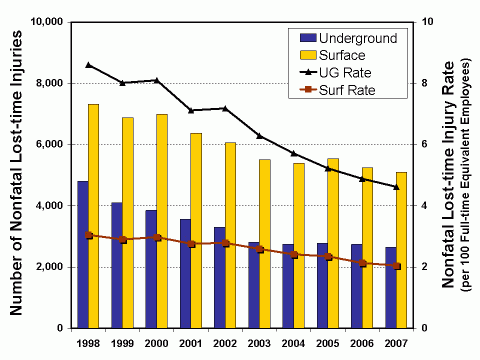Underground and Surface Mining Facts - 2007 (HTML)
DHHS (NIOSH) Publication No. 2009–158
Mining Operations
Data obtained from the Mine Safety and Health Administration (MSHA) indicated a total of 889 underground (6.0%) and 13,982 surface (94.0%) mining operations. [1]
Employees
A total of 55,617 employees, [2] or 57,222 full-time equivalent (FTE) [3] employees, were reported to MSHA as working at underground mining locations in 2007. This is in contrast to 322,506 employees (or 279,541 FTE employees) that were reported as working at surface locations. [4]
- Surface work location employee hours accounted for 83.0% of all hours reported to MSHA, while 17.0% of employee hours were reported for underground work locations.
- The majority of surface employee hours were for mine operator employees (80.0%) as opposed to independent contractor employees (20.0%).
- Coal operators were the mining sector [5] reporting the most underground worker employee hours to MSHA (n=84,475,287; 73.8%).
| Work Location | 1998 | 1999 | 2000 | 2001 | 2002 | 2003 | 2004 | 2005 | 2006 | 2007 |
|---|---|---|---|---|---|---|---|---|---|---|
| All | 655.0 | 638.1 | 624.9 | 621.0 | 582.7 | 569.2 | 598.2 | 635.1 | 662.5 | 673.5 |
| Surface | 543.3 | 535.8 | 529.8 | 520.7 | 490.6 | 479.7 | 501.8 | 529.0 | 550.4 | 559.1 |
| Underground | 111.8 | 102.4 | 95.1 | 100.3 | 92.1 | 89.6 | 96.4 | 106.1 | 112.1 | 114.1 |
Fatalities
Of the 67 occupational mining fatalities reported to MSHA in 2007, 27 occurred at underground work locations, while 40 occurred at surface locations.
- The fatality rate of 47.2 per 100,000 FTE employees was higher at underground work locations, compared to the rate of 16.1 for surface work locations.
| Fatalities | Number | Percent |
|---|---|---|
| Underground | 27 | 40.3 |
| Surface | 40 | 59.7 |
| Fatalities | Number | Percent |
|---|---|---|
| Coal operator | 18 | 66.7 |
| Metal operator | 3 | 11.1 |
| Nonmetal operator | 1 | 3.7 |
| Stone operator | 0 | 0.0 |
| Sand & gravel operator | 0 | 0.0 |
| Coal contractor | 3 | 11.1 |
| Noncoal contractor | 2 | 7.4 |
| Fatalities | Number | Percent |
|---|---|---|
| Coal operator | 10 | 25.0 |
| Metal operator | 4 | 10.0 |
| Nonmetal operator | 0 | 0.0 |
| Stone operator | 8 | 20.0 |
| Sand & gravel operator | 5 | 12.5 |
| Coal contractor | 3 | 7.5 |
| Noncoal contractor | 10 | 25.0 |
Nonfatal Lost-time Injuries
Within underground work locations, 2,645 nonfatal lost-time injuries were reported, resulting in 170,584 lost workdays. [6] This compares to 5,097 nonfatal lost-time injuries attributed to surface workers (total days lost = 255,635).
- The overall underground nonfatal lost-time injury rate was greater than the surface injury rate (4.6 vs. 2.0 per 100 FTE workers).
- The most frequent classification of nonfatal lost-time injuries involved handling materials for both underground (n=719; 27.2%) and surface (n=1,773; 34.8%) work locations.
- The back was the most frequently reported body part injured at both underground (n=414; 15.7%) and surface (n=957; 18.8%) work locations.
| Injuries | 1998 | 1999 | 2000 | 2001 | 2002 | 2003 | 2004 | 2005 | 2006 | 2007 |
|---|---|---|---|---|---|---|---|---|---|---|
| Underground number | 4,810 | 4,103 | 3,854 | 3,570 | 3,306 | 2,818 | 2,753 | 2,772 | 2,739 | 2,645 |
| Surface number | 7,322 | 6,881 | 6,985 | 6,379 | 6,052 | 5,504 | 5,386 | 5,538 | 5,249 | 5,097 |
| Underground rate | 8.6 | 8.0 | 8.1 | 7.1 | 7.2 | 6.3 | 5.7 | 5.2 | 4.9 | 4.6 |
| Surface rate | 3.1 | 2.9 | 3.0 | 2.8 | 2.8 | 2.6 | 2.4 | 2.4 | 2.1 | 2.0 |
Mining operations, 2007
| Commodity and Type of Employer | Underground Mining Operations [1] | Surface Mining Operations [1] | Total Mining Operations [1] |
|---|---|---|---|
| Coal Operator | 631 | 1,399 | 2,030 |
| Metal Operator | 97 | 181 | 278 |
| Nonmetal Operator | 48 | 677 | 725 |
| Stone Operator | 113 | 4,526 | 4,639 |
| Sand & Gravel Operator | Not applicable | 7,199 | 7,199 |
| Operator Total | 889 | 13,982 | 14,871 |
Contracting companies, 2007
| Commodity and Type of Employer | Number of Companies |
|---|---|
| Coal Contractor | 2,999 |
| Noncoal Contractor | 5,400 |
| Contractor Total | 8,399 |
Employment characteristics, 2007
| Commodity and Type of Employer | Underground Employees [2] | Surface Employees [2] | Total Employees [2] | Underground FTE Employees [3] | Surface FTE Employees [3] | Total FTE Employees [3] |
|---|---|---|---|---|---|---|
| Coal Operator | 37,829 | 46,242 | 84,071 | 42,238 | 51,027 | 93,265 |
| Metal Operator | 5,333 | 30,667 | 36,000 | 5,437 | 32,309 | 37,746 |
| Nonmetal Operator | 2,411 | 20,453 | 22,864 | 2,478 | 20,788 | 23,265 |
| Stone Operator | 1,845 | 80,873 | 82,718 | 2,063 | 81,191 | 83,254 |
| Sand & Gravel Operator | Not applicable | 45,761 | 45,761 | Not applicable | 38,340 | 38,340 |
| Operator Total | 47,418 | 223,996 | 271,414 | 52,216 | 223,655 | 275,871 |
| Coal Contractor | 5,160 | 33,705 | 38,865 | 3,071 | 19,670 | 22,741 |
| Noncoal Contractor | 3,039 | 64,805 | 67,844 | 1,935 | 36,216 | 38,151 |
| Contractor Total | 8,199 | 98,510 | 106,709 | 5,006 | 55,886 | 60,892 |
| Total | 55,617 | 322,506 | 378,123 | 57,222 | 279,541 | 336,763 |
Mining Occupational Fatalities (per 100,000 FTE employees), 2007
| Commodity and Type of Employer | Underground Fatalities | Underground Fatality Rate | Surface Fatalities | Surface Fatality Rate | Fatalities | Fatality Rate |
|---|---|---|---|---|---|---|
| Coal Operator | 18 | 42.6 | 10 | 21.1 | 28 | 31.2 |
| Metal Operator | 3 | 55.2 | 4 | 14.4 | 7 | 21.1 |
| Nonmetal Operator | 1 | 40.4 | 0 | 0.0 | 1 | 5.0 |
| Stone Operator | 0 | 0.0 | 8 | 11.4 | 8 | 11.1 |
| Sand & Gravel Operator | Not applicable | Not applicable | 5 | 15.0 | 5 | 15.0 |
| Operator Total | 22 | 42.1 | 27 | 13.8 | 49 | 19.7 |
| Coal Contractor | 3 | 97.7 | 3 | 16.3 | 6 | 28.0 |
| Noncoal Contractor | 2 | 103.4 | 10 | 29.3 | 12 | 33.3 |
| Contractor Total | 5 | 99.9 | 13 | 24.8 | 18 | 31.3 |
| Total | 27 | 47.2 | 40 | 16.1 | 67 | 21.9 |
Nonfatal Lost-time Injuries (per 100 FTE employees), 2007
| Commodity and Type of Employer | Underground Injuries | Underground Injury Rate | Surface Injuries | Surface Injury Rate | Injuries | Injury Rate |
|---|---|---|---|---|---|---|
| Coal Operator | 2,120 | 5.0 | 822 | 1.7 | 2,942 | 3.3 |
| Metal Operator | 178 | 3.3 | 620 | 2.2 | 798 | 2.4 |
| Nonmetal Operator | 91 | 3.7 | 417 | 2.4 | 508 | 2.5 |
| Stone Operator | 36 | 1.7 | 1,844 | 2.6 | 1,880 | 2.6 |
| Sand & Gravel Operator | Not applicable | Not applicable | 657 | 2.0 | 657 | 2.0 |
| Operator Total | 2,425 | 4.6 | 4,360 | 2.2 | 6,785 | 2.7 |
| Coal Contractor | 177 | 5.8 | 283 | 1.5 | 460 | 2.1 |
| Noncoal Contractor | 43 | 2.2 | 454 | 1.3 | 497 | 1.4 |
| Contractor Total | 220 | 4.4 | 737 | 1.4 | 957 | 1.7 |
| Total | 2,645 | 4.6 | 5,097 | 2.0 | 7,742 | 2.5 |
Data source: Publicly released data files of employment and accident/injury/illness collected by MSHA under 30 CFR 50.
Notes: All analyses of accident data exclude office employees. Occupational fatalities exclude all cases under 17 years of age. Further statistical methodology is available on the NIOSH Internet. Data in the above tables may not add to totals shown because of independent rounding. Caution should be used when interpreting rates based on a small number of events.
- Mines at which only independent contractors were working did not show any employment and were not counted.
- Average number of employees working at individual mines during calendar quarters of active operations (includes office workers).
- Full-time equivalent employees computed using reported employee hours (2,000 hours = 1 FTE).
- Surface work locations include surface operations at underground mines, surface operations (strip or open pit), auger, culm banks, dredge, other surface operations, independent shops and yards, and mills or preparation plants.
- Mining sectors include coal operators, metal operators, nonmetal operators, stone operators, sand and gravel operators, coal contractors, and noncoal contractors.
- Includes actual days away from work and/or days of restricted work activity. For permanently disabling injuries only, statutory days charged by MSHA were used if they exceeded the total lost workdays.
To receive NIOSH documents or more information about occupational safety and health topics, contact NIOSH at 1-800-CDC-INFO (1-800-232-4636), TTY: 1-888-232-6348, e-mail: cdcinfo@cdc.gov, or visit the NIOSH website.
See Also
- Coal Operator Mining Facts - 2005
- Metal Operator Mining Facts - 2002
- Metal Operator Mining Facts - 2004
- Metal Operator Mining Facts - 2005
- Noncoal Contractor Mining Facts - 2003
- Nonmetal Operator Mining Facts - 2002
- Nonmetal Operator Mining Facts - 2008
- Sand and Gravel Operator Mining Facts - 2006
- Stone Operator Mining Facts - 2003
- Stone Operator Mining Facts - 2005
- Page last reviewed: 2/19/2015
- Page last updated: 3/17/2014
- Content source: National Institute for Occupational Safety and Health, Mining Program


 ShareCompartir
ShareCompartir


